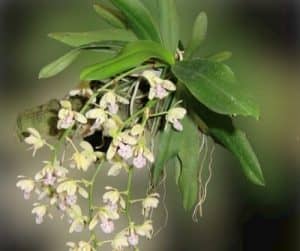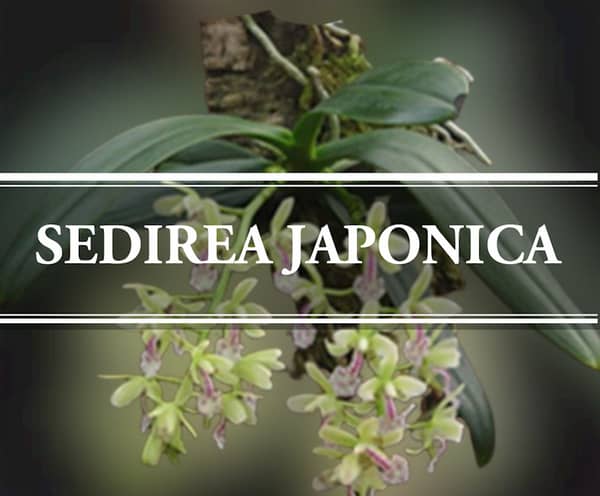Are you looking for a unique looking plant with attractive flowers and fewer leaves? We are going to discuss a popular orchid, the Sedirea japonica plant L. Andrew Garay and H. Royden Sweet described them back in the year 1974.
The short epiphytic grower remains under 40 cm in height. About 6 to 10 green elongated leaves grow on small stems. The scented flowers are green to pale yellow in color with irregular patterns.
In the wild, it grows on the tree trunks. However, domestically, you can grow them in containers, pots and hanging baskets. These natives of Japan are unique enough to be an eye-candy. An essential plant for plant enthusiasts, this easy-to-grow peep is even perfect for the beginners. Interesting? Let us know more about the Sedirea Japonica Orchid along with its classification and care.
Sedirea Japonica Classification
Family: Orchidaceae.
Genus: Sedirea.
Species: S.japonica
Genus Sedirea
This is a genus with currently only two recorded species. These two flowering plants japonica and the subparishii are epiphytes in nature. Moreover, they are native to the sub-tropical regions of China, Japan, and Korea.
Sedirea Japonica Common Names
The plant is associated with a number of common names;
- Japan Sedirea
- Phalaenopsis Japonica
- Phal Japonica
- Aerides japonica
- Sedirea Japonica Orchid
- Angraecum Japonicum.
Features of the Sedirea Japonica Plant

Height
- The maximum height of the adult plant becomes around 40 cm with a width of 10cm.
- The stem is monopodial and short.
Leaves
- This small orchid doesn’t grow a large number of leaves. A common mature plant has about 6 to 8 leaves, around 6 cm long and 2.5 cm wide.
Flowers
- The plant produces unique and pleasantly fragrant flowers in spring and summer.
- 6 to 10 flowers grown on about 20 cm long inflorescence.
- The petals are green to light yellow in color with prominent purplish streaks.
- Each flower is about 4 cm in size.
Resting Period
Well, this pretty peep has a small life span. It merely blooms in around 5 seasons. It is more likely that they need a resting phase to get their energy back. In fierce colds, they keep growing until they get completely exhausted and die eventually.
To prolong life, we suggest transferring them to warm spots. Moreover, the Phalaenopsis Japonica doesn’t need water unless the soil gets dry.
Cultivars
The plant is extensively cultivated to form a number of cultivars. Popular ones include;
- Standard
- Kibana Soshin.
- Minmaru
- Seigyokumaru. (A Small form of the Minmaru Japonica).
These cultivars show slight differences in appearance like size and height. However, the care and requirements of all of them are somewhat similar to the parent Sedirea plant as mentioned in the next section.
Sedirea Japonica Care
The basic requirements like water requirement, light and humidity depend upon the weather and your area. Thus, if you are new with this peep, better keep an eye on it and adjust the requirements accordingly.
Water Requirement
This plant needs to be wet all the time. All the time? Yes! The subtropical plant absolutely loves moisture. Water the soil along with the leaves twice to thrice a week to provide the required moisture. Moreover, on days with high temperature and dryness, you even need to water it several times a day.
However, with the beginning of autumn, the water requirement of the plant reduces considerably. Water after the soil gets dry out. Thus, about twice a week is usually enough to keep the plant healthy.
Excess of everything is bad. Thus, avoid over-watering and don’t let the soil get mucky.
Sunlight Requirements
Sedirea plant is adaptable to bright indirect light. An ambient room without direct light is the place to keep your Nagoran Japonica. Exposure to direct intense sunlight may readily scorch out the moss. Thus, make sure you keep the moss away from direct sunlight.
Temperature Requirements
The ideal temperature range to get the best foliage is between 70 to 80 °F. These subtropical natives have poor resistance to cold. So, don’t forget to transfer the plant before the temperature gets lower than 50 °F.
Soil Requirements
These plants need mixed soils with moisture-retaining but quickly drying particles. In addition, the soil should provide plenty of aeration to provide root rot.
Humidity Requirements
The humidity-loving Joponica Orchid plant needs at least 70% of moisture in the air. On dry days, consider misting the plant to keep the plant supple. Moreover, you can also go for a pebble water tray or a room humidifier.
Fertilizer Requirements
These plants will love the additional nutrition in the growing season. Give a monthly dose of any suitable orchid fertilizer in the months of April to August. Make sure you dilute it or use it in half or quarter of the recommended dose.
This orchid plant would be good to use sustainable fertilizers throughout the year. A fertilizer with high nitrogen content is used from spring up to the middle of the summer. Moreover, a fertilizer with high phosphorus content is needed by the plant in autumn. Additionally, this mini orchid doesn’t need fertilizers in the resting days of winter.
Pot Requirement
The plant grows well in deep pots with drainage and aeration. Additionally, you can grow them in smaller trays, pots, and hanging baskets as well. Surprisingly, you can even mount them on wooden slabs which reduces the chances of root rot.
Pruning Requirements
You can prune this plant to keep it in a suitable shape and size. Moreover, it helps to get rid of unhealthy plant parts and maintain its health. However, make sure you don’t remove the leaves in large number. As, the Japonica Orchid plant has already fewer leaves bad these are essential for it’s survival.
Summary
Sedirea japonica is a small-sized orchid with a height range of 40 cm. The small stem bares not more than 8 to 10 green elongated leaves. The beautiful, scented and showy flowers of this plant make it get the limelight among the plant enthusiasts. Clusters of 6 to 10 flowers with green to yellow petals and purplish irregular lines grow on long inflorescence stems.
The Sedirea japonica Care includes frequent watering to keep the soil wet, high humidity, and indirect light. This orchid plant can grow equally well in containers, pots, and hanging baskets. A variety of hybrids are created from this plant like the standard, minmaru and the seigyokumaru.

